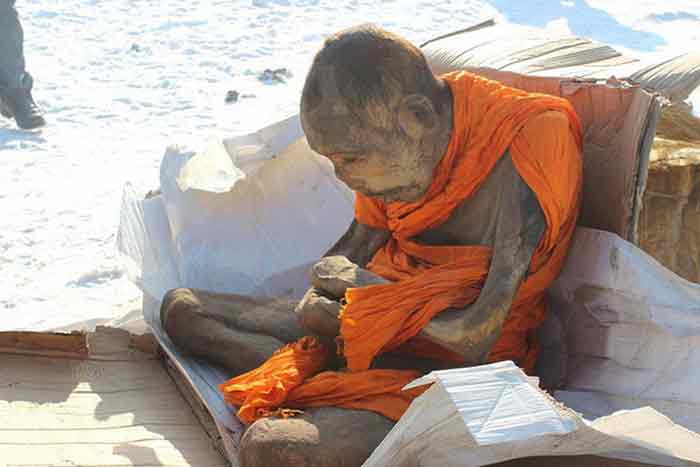
Tibetan Buddhists who view death as a process rather than an event and might assert that the spirit has not yet finished with the physical body.
For them, Thukdam begins with a “clear light” meditation that allows the mind to gradually unspool, eventually dissipating into a state of universal consciousness no longer attached to the body. Only at that time is the body free to die.
By Nazarul Islam
Not long ago, I had met and spoken to a group of Tibetan monks, visiting the Appalachian Mountains in the US. They were searching for love and inspiration. I had spoken with the group, and took down my notes of highly perplexing nature. Let me share this with my readers:
*The bodies of some Tibetan monks remain “fresh” after what appears to be their death.
*Their fellow monks say they’re not dead yet but in a deep, final meditative state called “thukdam.”
* Science has not found any evidence of lingering EEG activity after death in thukdam monks.
* It’s definitely happening, and it’s definitely weird. After the apparent death of some monks, their bodies remain in a meditating position without decaying for an extraordinary length of time, often as long as two or three weeks.
Tibetan Buddhists, who view death as a process rather than an event, might assert that the spirit has not yet finished with the physical body. For them, thukdam begins with a “clear light” meditation that allows the mind to gradually unspool, eventually dissipating into a state of universal consciousness no longer attached to the body. Only at that time is the body free to die.
Whether you believe this or not, it is a fascinating phenomenon: the fact remains that their bodies don’t decompose like other bodies. (There have been a handful of other unexplained instances of delayed decomposition elsewhere in the world.)
The scientific inquiry into just what is going on with thukdam has attracted the attention and support of the Dalai Lama, the highest monk in Tibetan Buddhism. He has reportedly been looking for scientists to solve the riddle for about 20 years.
He is a supporter of science, writing, “Buddhism and science are not conflicting perspectives on the world, but rather differing approaches to the same end: seeking the truth.”
The most serious study of the phenomenon so far is being undertaken by The Thukdam Project of the University of Wisconsin-Madison’s Center for Healthy Minds. Neuroscientist Richard Davidson is one of the founders of the center and has published hundreds of articles about mindfulness.
Davidson first encountered thukdam after his Tibetan monk friend Geshe Lhundub Sopa died, officially on August 28, 2014. Davidson last saw him five days later: “There was absolutely no change. It was really quite remarkable.”
What is the science behind this phenomenon?
The Thukdam Project published its first annual report this winter. It discussed a recent study in which electroencephalograms failed to detect any brain activity in 13 monks who had practiced thukdam and had been dead for at least 26 hours. Davidson was senior author of the study.
While some might be inclined to say, well, that’s that, Davidson sees the research as just a first step on a longer road. Philosopher Evan Thompson, who is not involved in The Thukdam Project, tells Tricycle, “If the thinking was that thukdam is something we can measure in the brain, this study suggests that’s not the right place to look.”
In any event, the question remains: why are these apparently deceased monks so slow to begin decomposition? While environmental factors can slow or speed up the process a bit, usually decomposition begins about four minutes after death and becomes quite obvious over the course of the next day or so.
As the Dalai Lama once said:
“What science finds to be nonexistent we should all accept as nonexistent, but what science merely does not find is a completely different matter – An example is consciousness itself. Although sentient beings, including humans, have experienced consciousness for centuries, we still do not know what consciousness actually is: its complete nature and how it functions.”
What is the consciousness behind this?
As thukdam researchers continue to seek a signal of post-mortem consciousness of some sort, it’s fair to ask what — and where — consciousness is in the first place. It is a question with which readers are familiar. We write about new theories all the time: consciousness happens on a quantum level; consciousness is everywhere.
So far, though, says Tibetan medical doctor Tawni Tidwell, also a Thukdam Project member searches beyond the brain for signs of consciousness have gone nowhere. She is encouraged, however, that a number of Tibetan monks have come to the U.S. for medical knowledge that they can take home. When they arrive back in Tibet, she says, “It’s not the Westerners who are doing the measuring and poking and prodding. It’s the monastics who trained at Emory.”
[author title=”Nazarul Islam ” image=”https://sindhcourier.com/wp-content/uploads/2021/05/Nazarul-Islam-2.png”]The Bengal-born writer Nazarul Islam is a senior educationist based in USA. He writes for Sindh Courier and the newspapers of Bangladesh, India and America. He is author of a recently published book ‘Chasing Hope’ – a compilation of his 119 articles.[/author]